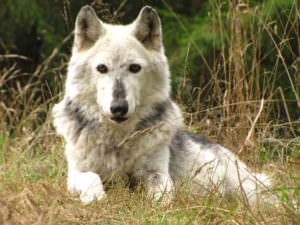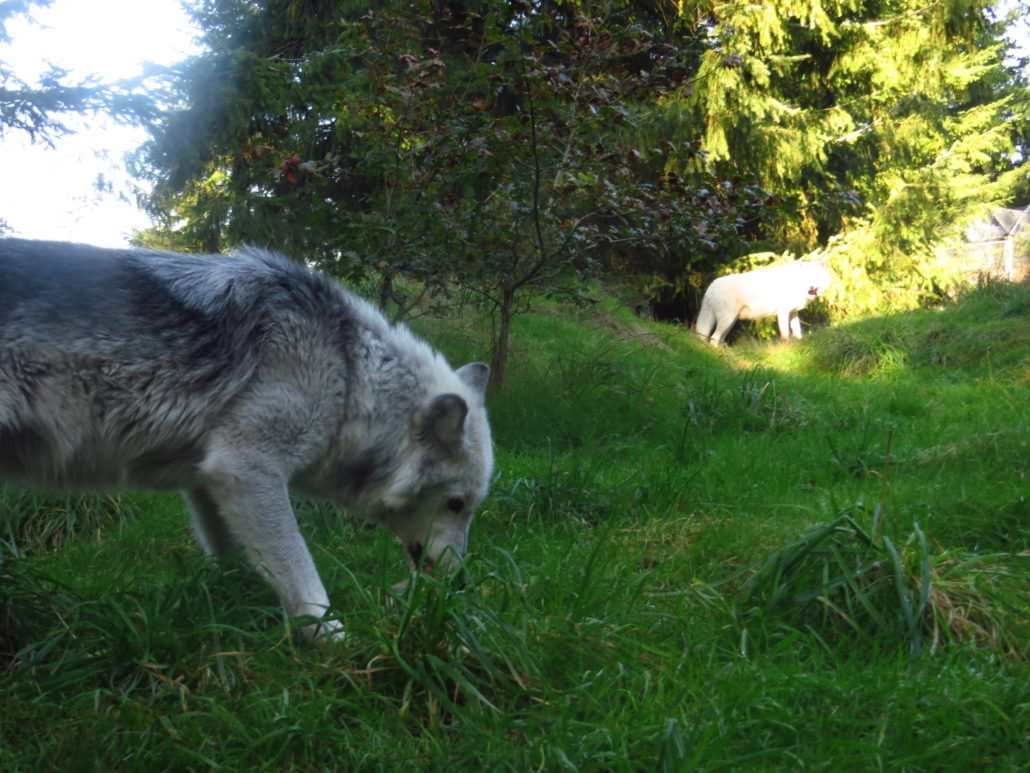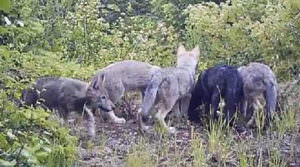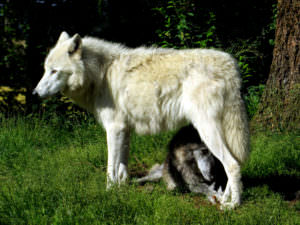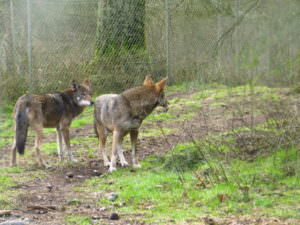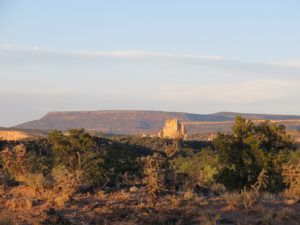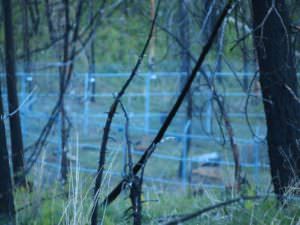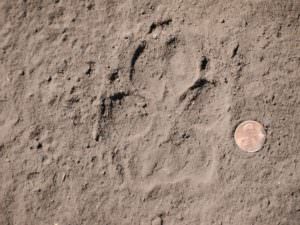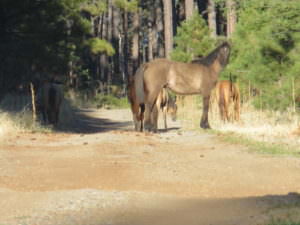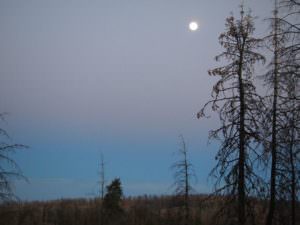An Unexpected Encounter
Surprise!
As if I didn’t think that Wolf Haven isn’t already the most amazing place, here is further affirmation: This morning at about 7:30, I was getting ready to head into the sanctuary and heard my dogs barking their heads off. My lab Harley is a “recreational” barker, so I tend not to pay too much attention, but my border/aussie is the best alarm system we could ask for.
Both were keenly focused in the direction of the service road that runs from the office and residential buildings out to the prairie. As I looked in that general direction, movement caught my eye and I saw a brown/black “slinky” looking animal. Too big to be a cat and the movement was all wrong but other than stray cats, coyotes and rabbits, there aren’t a lot of terrestrial animals that size that call Wolf Haven home. Upon closer inspection, it turned out to be an otter!
Just a few feet ahead of him or her were 3 or 4 more and then a few feet ahead of them, were another group of 4-5… all just booking it down the road!!! ten otters! We are fortunate to have a very healthy wetland on the west side of property and the pond has water year round, so we think that’s where they were heading and they seemed to know where they were going so perhaps it wasn’t their first walk-about at Wolf Haven. From a distance, Patt, Diane and I watched as they slinked away, chatting to one another the whole way. What an unbelievable way to start the day!
Wendy Spencer, Director of Animal Care
Wolf Haven International
Bart gets a companion!
If you follow us regularly then you know that Bart, one of our male wolves, has been very lonely since the passing of his sister Jinkies last month. For weeks after her passing we listened to his solo, mournful howls and our hearts ached for him but we knew that finding a new companion for him as quickly as possible would help with the healing process.
We had worked with Lockwood Animal Rescue (LARC) in the past when we rescued Bono, Eve and Klondike and we knew they were still looking to place animals so we contacted them shortly after Jinkies’ passing to see if they had a female that needed placing. Fortunately for all involved, 10 year old Samantha fit the bill perfectly. Samantha, like the other 3 rescues that LARC had helped facilitate, had originally come from the now-defunct Alaska road side attraction, Wolf Country USA . And just like Eve, Bono and Klondike, she too had spent most of her life staked out on an 8 foot drag chain so that visitists could pay $5 dollars to see wolves and wolfdogs up close.
After being rescued by LARC, Samantha (who is actually the younger sister of Eve) spent the next year and a half at their facility in southern California. And though she could have stayed, the owners of LARC felt as though she might do better in a sanctuary setting.
As it turned out, the male that Samantha was housed with at the time was moving to W.O.L.F, a wolfdog sanctuary in La Porte, Colorado, so it made sense to do both transfers at the same time. We selected a location that was convenient for all 3 facilities (Provo, UT) as well as a date (September 4th).
Diane and I set out on Tuesday evening at 7pm, in the hopes that we would arrive in Provo the following afternoon in time to get a few hours of sleep before meeting up with the folks from LARC and WOLF, picking up Sam and then getting back on the road.
 Sixteen hours and many cups of coffee later we arrived in at our designated meeting spot- the Days Inn parking lot and waited for the LARC volunteers (and Sam) to arrive. We had a few hours to kill, so we had an early dinner with the WOLF folks and then tried to get some sleep in our cargo van. Leave it to me to pick the one spot in all of Provo that had a disgruntled feral peacock who wanted the entire neighborhood to know the extent of his ire. And just about the time the peacock let up, a landscape crew showed up with lawnmowers, weed whackers and even a chain saw! No sleep for us L
Sixteen hours and many cups of coffee later we arrived in at our designated meeting spot- the Days Inn parking lot and waited for the LARC volunteers (and Sam) to arrive. We had a few hours to kill, so we had an early dinner with the WOLF folks and then tried to get some sleep in our cargo van. Leave it to me to pick the one spot in all of Provo that had a disgruntled feral peacock who wanted the entire neighborhood to know the extent of his ire. And just about the time the peacock let up, a landscape crew showed up with lawnmowers, weed whackers and even a chain saw! No sleep for us L
Stanley and Greg (volunteers from LARC) arrived around 8 pm and we quickly and quietly transferred Samantha into our waiting van. It was dark by that time so we were not able to get a good look at her other than to see the yellow of her eyes reflected in the parking lot lights. Unlike some of the wolves that we rescue who hunker nervously in the back of their crate, Samantha was up at the front, ears pricked forward, taking in the sights and sounds of her surroundings as we headed for home.
Every once in awhile I would catch a glimpse of her beautiful face as we would pass under a street light but it wasn’t until the following morning that we got our first good look at her. She was perfect. Now 10, her black has phased to that silvery-blue that is so typical of wolves but like her sister, Eve, she has a dark strip that runs down her nose. Curled in the crate, it was hard to tell how big she was, but we got the sense that she was fairly slight but with the characteristically long, thin legs and giant feet.
She was the perfect passenger and though she would lay her head down occasionally, she would not allow herself to fall into a deep sleep- for even though outwardly she seemed calm and relaxed, this was undoubtedly scary for her so she remained vigilant.
We drove straight through and arrived at Wolf Haven the following afternoon at 1. We drove directly to Bart’s enclosure and let her into the sub-enclosure (deckpen). A chain link guillotine gate separates the two but they are still able to see and sniff and even touch noses, if they so choose but it is also serves as a safety barrier in the event that the two do not get along.
Raise Your Voice for Wolves – No to Delist!
UPDATE ON GRAY WOLF DELIST PROPOSAL!
The comment period has officially been extended to 10/28! Because of the strong public response to this proposal, USFWS will hold three public hearings: DC, Sacramento and Albuquerque. Dates have yet to be determined, so stay tuned. If you live near any of these cities, please consider attending one of the hearings & speaking out for wolves.
Raise your voice for wolves!
You only have until September 11, 2013, to send your comments to the US Fish and Wildlife Service (USFWS) on their proposal to delist gray wolves in the lower US. Your comments are critical – conservation organizations throughout the US are striving to have 1 million comments sent to the USFWS to emphasize the importance of this issue for the continued recovery of wolves in the lower US.
Here are some points to consider including in your comments:
- Delisting gray wolves throughout the lower 48 is premature and contradicts the best available science. The gray wolf has barely begun to recover or is absent from significant portions of its former range where substantial suitable habitat remains. The USFWS draft rule fails to consider extensive suitable habitat in the Pacific Northwest, California, the southern Rocky Mountains and the Northeast. It also fails to consider the importance of these areas to the long-term survival and recovery of wolves, or the importance of wolves to the ecosystems of these regions. The very scientists whose research is referenced in the draft rule to remove the gray wolves’ protections have stated publicly that the science does not support the delisting.
- If delisted, wolves throughout Washington will lose federal protections, which will allow for more lethal control under our current Washington Wolf Conservation and Management Plan.
- Wolves were delisted in 2011 in the northern Rockies, and recreational wolf hunting has significantly reduced wolf populations in those states. Washington’s wolf population largely originated from these adjacent states, and under full federal protection have flourished and expanded. Less wolves dispersing into Washington and the proposed loss of federal protection could greatly reduce the chances for wolves to continue to repopulate areas of Washington that do not have wolves at this time such as Southwest Washington, the North Cascades, and the Olympic Peninsula.
-
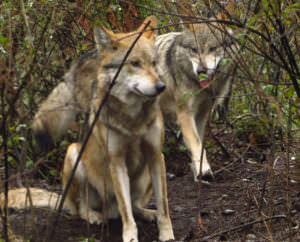
These Mexican gray wolf brothers currently reside at Wolf Haven International and are pre-release candidates.
Giving Mexican wolves their own Endangered Species Act listing is long overdue, however, delisting gray wolves throughout the U.S. is counter to protecting Mexican wolves. Fewer than 80 Mexican gray wolves exist in the wild. New populations of these wolves are desperately needed for them to thrive. The best available science confirms that the Grand Canyon region and the Southern Rockies are essential for Mexican wolf recovery. But the proposed rule will leave gray wolves unprotected in these places, making the survival of Mexican gray wolves much more difficult should they expand into new areas.
- A comprehensive recovery plan is needed for Mexican wolf. The current recovery plan was written in 1982 and lacks up to date scientific information. Once a recovery plan is written, any proposed changes should support that plan and should not conflict with recovery needs of the Mexican wolf.
- Allow more Mexican wolves to be released in more places, particularly into suitable habitat outside currently proposed release areas that scientists say is the best habitat and is critical for recovery. At least two more populations of Mexican gray wolves need to be established. Picking up wandering wolves and returning them to the proposed recovery area will inhibit the dispersal of new genes, which is necessary to keep wolves healthy.
WHAT TO DO
Written comments and information concerning each proposed rule can be submitted by one of the following methods to the appropriate docket numbers:
Federal eRulemaking Portal: www.regulations.gov Follow the instructions for submitting comments to the following docket numbers:
Gray wolf: Docket No. [FWS–HQ–ES–2013–0073]
Mexican Wolf: Docket No. [FWS-R2-ES-2013-0056]
Linda Saunders, Director of Conservation
Wolf Haven International
Summer Days at Wolf Haven
Sanctuary Update – Brennan Stoelb, animal care specialist
Blooming flowers and budding trees have given way to the smell of fresh cut grass and finding a shady spot to read a book. Summer is here!
Our oldest gal Clarice is doing well. She is currently taking two medications for some incontinence issues, which isn’t uncommon given her age. One of the medications, DES, has a very high success rate. While it hasn’t completely relieved her symptoms, there has been measured improvement while on DES. For a couple of months, she was on a roasted chicken kick as an extra morning snack. Then she decided roast was a better breakfast. After a few weeks, she went back to chicken. Recently, she has gone back to preferring beef roast. How long roast will be the preferred meat is anyone’s guess, but we are more than happy to accommodate Clarice! She is 18 after all.
In the spring issue, I mentioned the challenges we were having pilling our older female Kiawatha. We are pleased to report that she also loves raw beef roast. She likes it so much that most mornings she eagerly runs to the fence for her roast!
Between mowing the grass and weed-whacking, we have made some changes to the sanctuary. Guy and Anna, who were in the enclosure behind Juno and Shadow, have a new home in the back of the sanctuary with lots of seclusion! Not only does this allow Guy and Anna, who are a bit on the shy side, more privacy, but it also allows Juno and Shadow access to a second enclosure. Sometimes Shadow gets a little wary of certain types of cameras and this new arrangement allows him a buffer zone. Both pairs appear very happy with the new set-up!
Everyone was hopeful this year as we observed, via remote camera, three of the four Species Survival Plan (SSP) pairs that were recommended for breeding, actually engaged in breeding behavior. Unfortunately, due dates came and went without pups.
Tamaska, one of our female red wolves, looked pregnant and even spent hours in her den. Spirits were high among staff members. We were slightly concerned when Tamaska’s mate Jacob was seen entering the den, which typically the female would not allow. To get a better view of the goings-on, we borrowed a “snake” camera from a local plumber, Advanced Plumbing Technologies, and had a peek in her den. Unfortunately, only rocks were found. It remains uncertain if she was going through false pregnancy, if she miscarried, or if the pups were stillborn.
Pups or no pups, come on out for a visit and take a visit of the sanctuary. While you’re here, lose yourself meandering through our gorgeous mounded prairie.
Helping Save Mexican Wolves – A piece of my heart
Nearly exterminated in the wild during by the 1930s, the Mexican wolf remains one of the most endangered mammals in North America. In May, Wolf Haven’s Director of Animal Care Wendy Spencer assisted in the care & observation of two wolves scheduled for future release. This is Part 12 – the final chapter in an ongoing series of blog posts about her experience in Arizona.
The following morning, all was quiet at the pen. The wolves had opted to sleep in so it would be almost 40 minutes before I saw either one of them and even then, it was brief. We had heard fence fighting all night long until about 2:30 in the morning, so after such a long day and night, they were most likely exhausted. Since this was to be my last morning at the blind and watching the wolves, I said a little prayer and wished them a long, happy and safe life.
Back at camp, it was time to pack up and get on the road to Albuquerque. There was definitely a part of me that did not want to leave, so it was with mixed emotions that I loaded up and said goodbye. As I made towards Alpine, winding along the dry, dusty roads, I was reflected on the week that just passed. It was truly one of the most profound experiences I have ever had and even though it had only been a week, I felt as though I was leaving a little piece of my heart in the Apache forest and with all those who lived there too.
Update: The day I departed, the IFT set traps by the pen in hopes of trapping and collaring the unknown wolf. I received word a few days later that they were indeed able to trap and collar her and she is now identified as F1305. Because the free ranging pair continued to localize around the pen site and appeared prepared to defend their territory if the Coronado pack was released, it was with great disappointment that the IFT decided to return M1051 and F1126 back to captivity. It was by no means an easy decision for the field team but after giving it very careful consideration and evaluating all the pros and cons associated with going forward with the release, it was decided that removing the Coronado pack and returning them to captivity was in the best interest of all the wolves involved. However, just because the pair did not go out this season, they are still slated for release at some point in the next year. The Alpine wilderness has not seen the last of these two.
Helping Save Mexican wolves (#10) – F1305 just wants to have fun
Nearly exterminated in the wild during by the 1930s, the Mexican wolf remains one of the most endangered mammals in North America. In May, Wolf Haven’s Director of Animal Care Wendy Spencer assisted in the care & observation of two wolves scheduled for future release. This is Part 10 of an ongoing series of blog posts about her experience in Arizona.
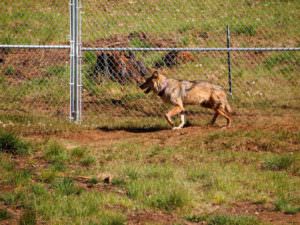 While M1107 would take a time out from fence fighting, F1305 would play on the nearby log pile. She had what would be analogous to a play face and though her tail was straight up, her movements were exaggerated and clumsy as she would often try and invite M1107 to play.
While M1107 would take a time out from fence fighting, F1305 would play on the nearby log pile. She had what would be analogous to a play face and though her tail was straight up, her movements were exaggerated and clumsy as she would often try and invite M1107 to play.
He wanted no part though, as he was clearly in battle mode and focused solely on his rivals. Obviously, there was a conversation that took place between him and the pair because after several minutes of truce (and rest) the three wolves would once again take up their positions at the fence and resume fighting. Meanwhile, the little female would bow and jump around in circles- clearly she did not take this as serious as her new companion did. However, when the fence fighting would increase in intensity, then she would join the fray briefly.
The fence fighting continued for almost 2 hours but just before 7 am, I observed the pair walk over to far side of the pen and curl up in a day bed. M1107 paced back and forth along the fence line as if trying to encourage them to come back, but to no avail. Realizing the pair was not going to take his bait, he headed towards the north side of the pen where he took up post like a sentry. He eventually lay down, but kept a watchful eye. The little female was relentless in her attempts to get M1107 to play- she kept pouncing his head and playfully nipping at his rump, but he ignored her. Perhaps out of sheer boredom, she eventually laid down as well.
Throughout the morning either M1107 or F1226 would initiate a howl but all four would stop what they were doing and join in- it was mesmerizing. Even as I made my way back to camp, I would hear their melodic chorus as it drifted by, carried on the early morning breeze. However, in addition to the howling, I heard bouts of fighting as well and that continued well on into the late morning….. (to be continued)
Helping Save Mexican wolves (#9) – fence fighting between free-ranging & captive wolves
Nearly exterminated in the wild during by the 1930s, the Mexican wolf remains one of the most endangered mammals in North America. In May, Wolf Haven’s Director of Animal Care Wendy Spencer assisted in the care & observation of two wolves scheduled for future release. This is Part 9 of an ongoing series of blog posts about her experience in Arizona.
As I headed to the blind the next morning, a herd of elk cut me off as they made their way across the road. They were huge and beautiful and a picture of sheer grace as they trotted by, except for the baby who was still a bit wobbly.
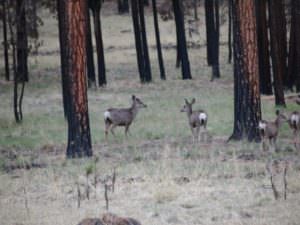 As I crested the ridge, I could hear loud whimpering and whining coming from the pen, amplified by the surrounding hillsides. I was still too far off to see the pen but the sounds continued as I approached. Out of the corner of my eye I saw a group of mule deer slinking past me. Their eyes were as big as saucers and even an uneducated observer like me could tell they were concerned about something. I continued to make my way down to the blind and as the pen came into view I could see movement along the perimeter in front of me.
As I crested the ridge, I could hear loud whimpering and whining coming from the pen, amplified by the surrounding hillsides. I was still too far off to see the pen but the sounds continued as I approached. Out of the corner of my eye I saw a group of mule deer slinking past me. Their eyes were as big as saucers and even an uneducated observer like me could tell they were concerned about something. I continued to make my way down to the blind and as the pen came into view I could see movement along the perimeter in front of me.
It turned out to be an elk darting back and forth along the fence line and M1051 and F1126 were 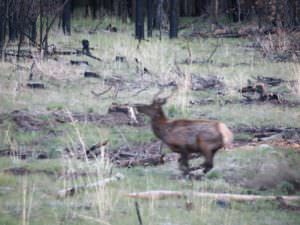 frantically running alongside him. Seconds later I caught a glimpse of something behind the elk but I was still far away and the lighting was poor but the animal looked decidedly canine. I couldn’t believe my eyes! The elk suddenly turned away from the pen and began running up the hill just to the left of the blind and by that time I had made it to the blind and I could make out the distinct coat color and pattern of a Mexican gray wolf as he gave chase to the elk. They both disappeared from view but I could hear them crashing through the woods.
frantically running alongside him. Seconds later I caught a glimpse of something behind the elk but I was still far away and the lighting was poor but the animal looked decidedly canine. I couldn’t believe my eyes! The elk suddenly turned away from the pen and began running up the hill just to the left of the blind and by that time I had made it to the blind and I could make out the distinct coat color and pattern of a Mexican gray wolf as he gave chase to the elk. They both disappeared from view but I could hear them crashing through the woods.
Meanwhile, the wolves in the pen were coming unhinged. They were whimpering and whining and alarm bark/howling- a clear sign that they were agitated and in distress. Even with the naked eye I could see their hackles standing on end from head to tail, with tails held straight up in the air. They quickly bolted to the opposite side of the fence as a wolf came running to the fence and they began fence fighting with each other but this did not look like the same wolf that I watched run after the elk. All of a sudden, the elk came tearing towards the pen again, with the wolf still in tow! The elk found himself caught in between the two free ranging wolves and repeatedly darted back and forth. However, at one point the two wolves took time away from the elk to fence fight with the pair. The fighting became so intense that it was in that moment that the young spike saw his opportunity to get away and I watched as he bolted up the far hill and eventually out of sight.
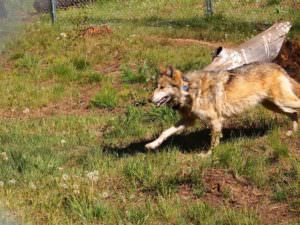 I could not believe what I was seeing! The wolves would periodically take a break from fighting and essential go off to their own corners which allowed me to get good visuals through the scope. I could clearly see a radio collar on one of the free ranging wolves, who presumably was M1107. Even though I didn’t pick up his signal at all during the night, he was the only wolf that had been known to visit the pen site. Also, he was one of just a handful of wolves equipped with a GPS collar and through the scope I could see the telltale antenna. The other wolf looked and behaved like a juvenile- most likely a yearling. She was much darker in color and her markings were more muted than the other wolves. And although there was no clear indication as to whether she was indeed a female, she just “looked” female to me.
I could not believe what I was seeing! The wolves would periodically take a break from fighting and essential go off to their own corners which allowed me to get good visuals through the scope. I could clearly see a radio collar on one of the free ranging wolves, who presumably was M1107. Even though I didn’t pick up his signal at all during the night, he was the only wolf that had been known to visit the pen site. Also, he was one of just a handful of wolves equipped with a GPS collar and through the scope I could see the telltale antenna. The other wolf looked and behaved like a juvenile- most likely a yearling. She was much darker in color and her markings were more muted than the other wolves. And although there was no clear indication as to whether she was indeed a female, she just “looked” female to me.
Up until this point, everyone on the IFT thought that M1107 was traveling alone but somewhere on his travels, he managed to pick up this little female- perhaps a yearling from the Maverick pack….. (to be continued)
Helping Save Mexican Wolves (#8) – wild wolves, wild horses, & magic
Nearly exterminated in the wild during by the 1930s, the Mexican wolf remains one of the most endangered mammals in North America. In May, Wolf Haven’s Director of Animal Care Wendy Spencer assisted in the care & observation of two wolves scheduled for future release. This is Part 8 of an ongoing series of blog posts about her experience in Arizona.
Recently the IFT had confirmed the alpha female of the Bluestem pack had 5 pups, which brought their total to 10- the largest pack in the area. In order to try and insure that they stayed out of trouble, the IFT decided to temporarily put out a cache pile so Quinn and I left a few dozen pounds of carnivore logs for them. The wolves were obviously coming in and feeding off the pile because tracks were all around the area and there was a trail camera set up in order to visually confirm that the wolves were indeed coming in and eating from it rather than being totally scavenged by ravens.
Then we went looking for the remaining member of the Hawk’s Nest pack. We drove over to his known range and because the wolves prefer to travel on the existing forest service roads, it was fairly easy to pick up his tracks. It was obvious to me that Quinn was familiar with this male and his habits because Quinn just opened the door to his truck as he slowly drove until he was able to spot a track. From there we got out and followed his trail a bit before it disappeared into the tree line.
As we drove back to the trailer we came across a group of wild horses grazing in a meadow off the side of the road. Apparently the forest is home to about 100 horses that have wandered off the Fort Apache Indian Reservation (FAIR) and now live amongst the elk, deer and big horn sheep that call the forest home. They were so beautiful and majestic- I just sat and watched from a distance while they were in the area. They didn’t seem to give a rip about us, but as a horse person, I was thrilled to have a chance to see them- what a gift!
Nighttime in the Apache is magical- the moon was waxing gibbous that week so each night, the forest was bathed in pale yellow moonlight, silhouetting the old aspens against the midnight skies that were adorned with millions of stars. The forest came alive at night and I imagined the revelries of its inhabitants as I stood with my telemetry equipment in hand, afraid to turn it on, lest it somehow disturb them. In those moments, I had an abiding awareness of my intrusion into this secret, enchanted world of the forest but did my best to minimize my incursion………… (to be continued)


